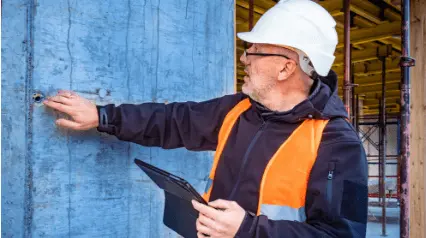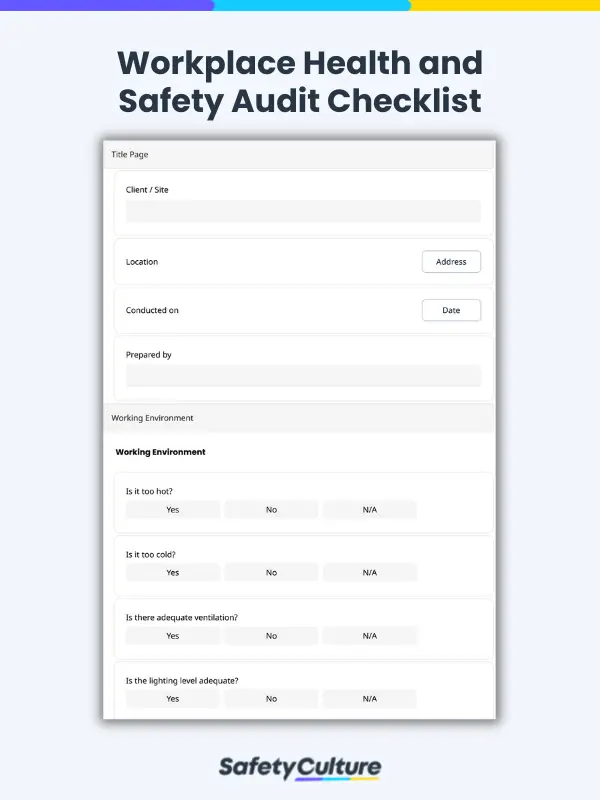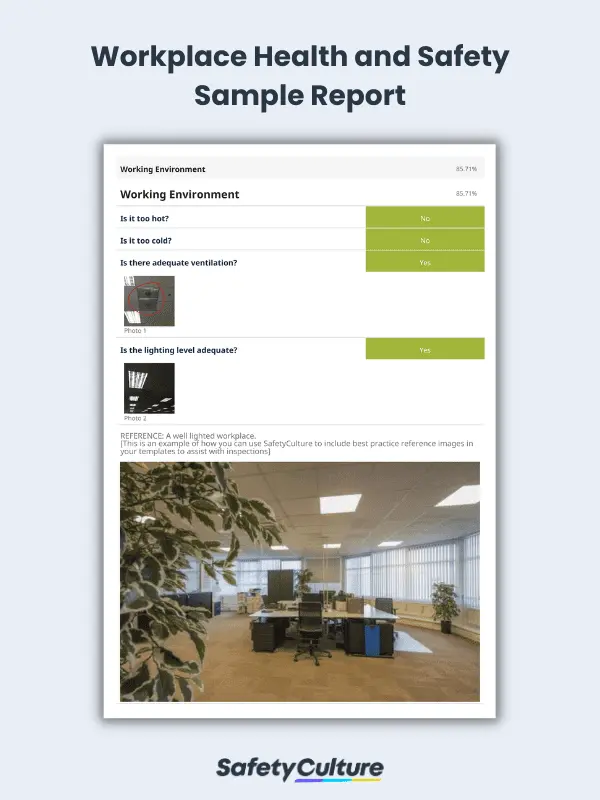What is a Health and Safety Checklist?
A health and safety checklist is a tool used to reinforce Workplace Health and Safety (WHS) practices and help organizations comply with safety rules and regulations. Performing regular inspections using health and safety checklist templates is a proactive approach to preventing work-related incidents, injuries, and illnesses.
The use of health and safety inspection checklists can also help organizations apply the latest best practices for situations or changes in the workplace that impact lives and livelihoods.
What are the 5 Elements of Safety?
A behavior-based program in the workplace is the first step toward an effective safety culture, but it isn’t the only step. More than using health and safety checklist templates, a culture of safety is an alignment of attitudes, beliefs, and values across teams in an organization in relation to safety. Collaboration is vital in ensuring a successful organizational safety culture so that everyone makes a conscious effort to promote their own and others’ safety.
Focusing on the elements below will help in creating and promoting a collaborative safety culture:
- Leadership
Leading by example is the best way to promote a strong safety culture in an organization. Leaders should demonstrate a model for safe and healthy behavior that everyone else can follow. As such, people in management should have a firm grasp of the elements and principles of safety and good health.
- Responsibility
A sense of responsibility should be shared by everyone in the organization so that a safety culture can be promoted and implemented. Each individual within the organization should share the belief that they are all morally and ethically bound to act in a way that safeguards and promotes the health and safety of fellow employees, the company, and society as a whole.
- Accountability
Management teams and team leaders should be held accountable for the people they oversee. Setting an example is vital because the behavior of leaders will influence the behavior of those around them. This also means that promoting a safety culture should be integrated into the responsibilities of leaders.
- Clear expectations
The expectations that come with creating an organization-wide safety culture should be set at the onset and communicated properly to everyone across the organization. Commitment to an organization’s safety culture must come from the top because the quickest way to spread this commitment is from the top down. Employees will be encouraged to adhere to and promote a safety culture if it’s evident that their leaders are committed to the cause.
- Ethics
It should go without saying that management systems should be driven by ethics—and it’s the same with the creation of a safety culture. The goal of a strong safety culture is not only to ensure that employees adhere to set safety rules but also to guide them in making decisions that are moral and ethical. A company should hire people who share its core values and know how to make rational and ethical decisions in their everyday lives.
How Can You Identify Health and Safety Problems?
Every workplace will have hazards; depending on the industry, businesses will have to contend with different types of hazards that come with the job. The question is, are these hazards avoidable, and can they be identified before they cause untoward incidents?
It is an employer’s legal responsibility to look after employees and protect them from health and safety hazards in the workplace, and knowing the common types of hazards is the first step in avoiding work-related accidents and injuries.
- Physical hazards
This is the most common workplace hazard. Contrary to popular belief, physical hazards don’t need to make contact with a person to cause harm. These include extreme temperatures, prolonged exposure to the sun, radiation, and constant exposure to loud noises.
- Ergonomic hazards
Ergonomic hazards are present when the nature of work puts employees under stressful conditions or cases when the body is put under significant strain. Ergonomic hazards are often unrecognized because the harm that they cause is not immediate. Some conditions that pose ergonomic hazards include non-ergonomic workstations, frequent lifting without following best practices, repetitive movements, repeated forcible motion, and exposure to constant and excessive vibration.
- Chemical hazards
Chemical hazards are present if workers are exposed to any harmful chemical substance in any form (solid, liquid, or gas). Different substances have different levels of risk, and individuals will have different levels of tolerance to different chemical substances. Chemical hazards include pesticides, cleaning solvents, flammable substances, dangerous gases, and vapors and fumes from welding or solvents.
- Biological hazards
Biological hazards are present when the nature of work involves working with animals, infectious plants, and bacteria and viruses that can cause adverse health effects.
Every workplace, regardless of the industry, will have its own set of hazards that can endanger the safety of employees. One of the best ways to identify these risks is by using a dedicated health and safety checklist for your workplace.
Benefits of Using a Safety Checklist
A health and safety checklist proves to be an essential tool for ensuring workplace safety. For one, it simplifies the process of identifying and assessing workplace risks by mapping out the essential safety aspects, measures, and considerations. This way, safety officers can carry out these checks in a streamlined fashion and maintain safety standards across the organization.
With the data gathered from this safety checklist, organizations can proactively address the identified hazards and take preventive measures before they escalate. This practice notably reduces the likelihood of unfortunate workplace accidents, injuries, and illnesses. And when consistently done, it creates a safer working environment and promotes a culture of safety.
Lastly, a health and safety checklist is a valuable record of your organization’s commitment to your employee’s safety and well-being. It demonstrates, in writing, that you have implemented reasonable steps to determine and rectify workplace risks. This can be submitted to authorities as proof of compliance with relevant health and safety regulations and standards.
4 Types of Health and Safety Checklists
Safety checklists come in various types and formats depending on the industry and hazard to be addressed. Here’s a quick overview of the 4 common types of health and safety checklists used in the workplace:
General Safety Checklists
A general safety checklist is fundamental for evaluating overall safety measures in workplaces. They cover a wide range of safety factors applicable to most industries and work environments, such as Personal Protective Equipment (PPE), fire safety, and emergency procedures.
Workplace Safety Checklists
Workplace-specific checklists are tailored to address safety concerns and hazards unique to a particular industry or setting. They focus on mitigating risks associated with specific tasks on the job. Here are a few examples:
- Construction Site Checklist
This type of safety checklist tackles potential dangers present in construction sites resulting from heavy machinery, elevated structures, hazardous materials, and other factors. Thus, it should cover topics such as scaffolding safety, fall protection, proper handling of tools and equipment, and regular machine inspections.
- Laboratory Safety Checklist
This safety checklist deals with hazardous substances and processes that require strict safety protocols in the laboratory. It should include guidelines for chemical storage and handling, proper PPE use, waste disposal procedures, and equipment maintenance.
- Warehouse Safety Checklist
This checklist seeks to identify and assess potential risks during warehouse operations. Thus, it should examine the general warehouse environment, dock areas, equipment, and sanitation practices, especially for food storage facilities.
Equipment Safety Checklists
Equipment safety checklists revolve around upholding safety standards for tools, equipment, or machinery used in the workplace. They ensure that the equipment is in good working condition and that employees are sufficiently trained to operate it safely. Examples of this include:
- Forklift Safety Checklist
Equipment-specific checklists for forklifts should include pre-start inspections, proper loading and unloading techniques, safe maneuvering in narrow spaces, and refueling procedures.
- Electrical Equipment Checklist
Checklists for electrical equipment must contain routine inspections, testing for electrical grounding, verification of circuit protection devices, and storage of flammable materials away from electrical sources.
- Hand and Power Tools Checklist
Checklists for this type of equipment should evaluate the condition, functionality, and safe operation of hand and power tools. They should also allow space to report issues and defects found.
Process Safety Checklists
Lastly, process safety checklists outline safety considerations during specific work activities or processes. They will walk employees through the steps and precautions to exercise when carrying out their day-to-day jobs. Some examples include the following:
- Confined Space Entry Checklist
Confined spaces present unique risks due to limited ventilation and potential exposure to toxic substances. Because of this, your checklist must specify measures for atmospheric testing, proper use of personal protective equipment, communication procedures, and emergency rescue protocols.
- Hazardous Material Handling Checklist
Employees working with hazardous materials must strictly follow safety guidelines to prevent contamination and accidents. Thus, their checklist should run through the steps for proper storage, labeling, transportation, and disposal procedures in compliance with relevant regulations.
What Should You Include in a Health and Safety Checklist?
Using checklists during health and safety inspections paves the way for a safe and secure work environment. So if you’re creating a general health and safety checklist for the first time, make sure to include the following areas:
- Overall working environment
- Housekeeping
- Material storage
- Electrical safety
- Ladders and step ladders
- Kitchen areas
- Toilet facilities
- First aid
- Fire precautions
- Fire instructions
- Control of Substances Hazardous to Health (COSHH) requirements
- Machinery
- Personal Protective Equipment (PPE)
- Eyewash bottles and cylinders
- Outside areas
To illustrate how this works, here’s an example of a health and safety report accomplished using a checklist:
FAQs about Health and Safety Checklists
Health and safety checklists can be used by anyone responsible for workplace safety, including employers, safety managers, supervisors, and employees. They are a valuable resource for performing regular inspections and finding potential work-related risks.
While using this checklist is not necessarily a legal requirement, it can work as a guiding tool for ensuring compliance with health and safety standards and regulations.
Check with your local authorities and regulatory agencies to find specific legal requirements applicable to your location. Aside from this, consider looking into industry associations and occupational health and safety organizations for guidelines and best practices to incorporate into your checklist.
To keep your checklists relevant and reliable, they must be regularly reviewed and revised according to the changes in regulations or workplace conditions. It also helps to ask for feedback from employees, supervisors, and safety professionals to identify improvements, meet the current workplace needs, and continuously improve the quality and usability of the checklist.




